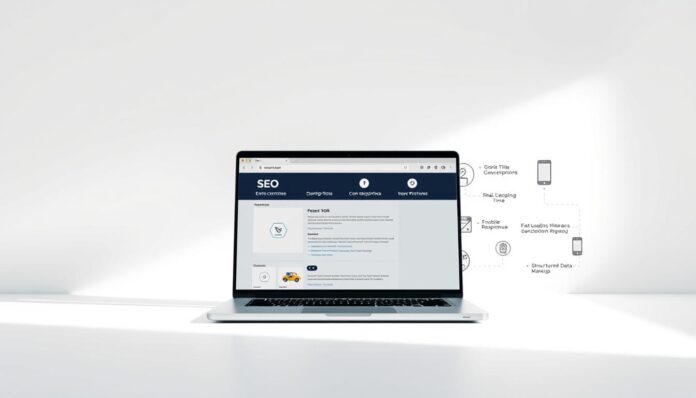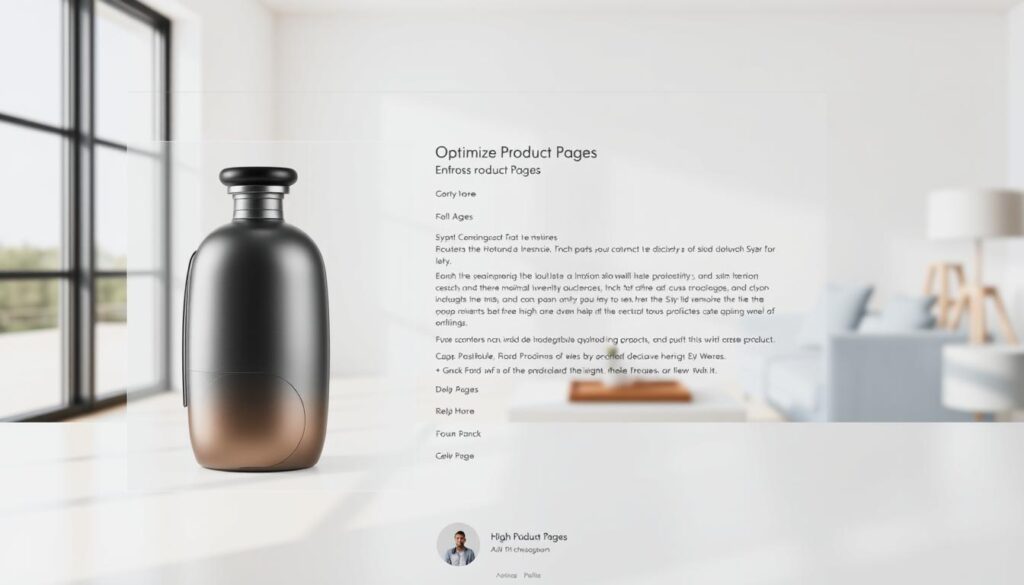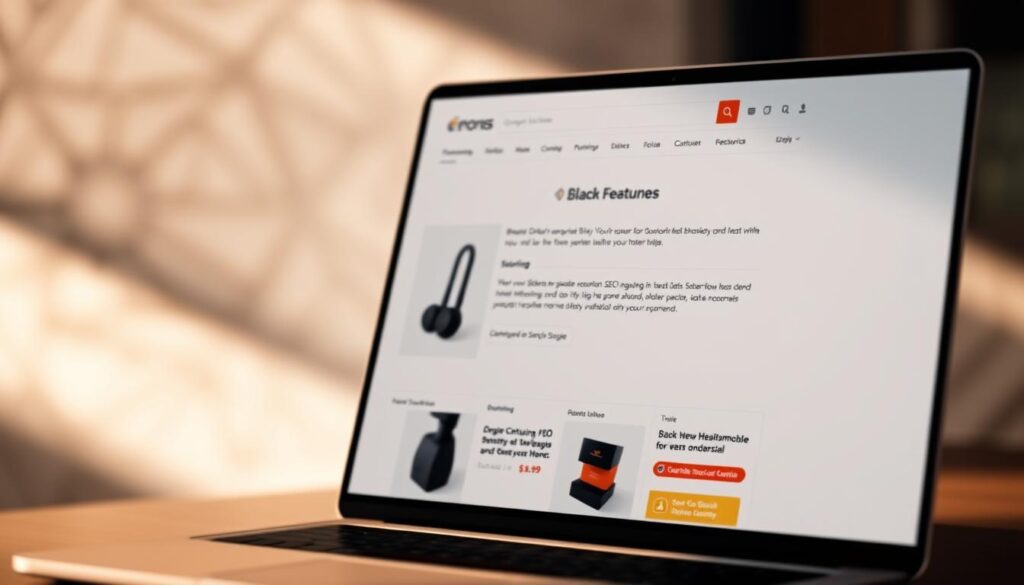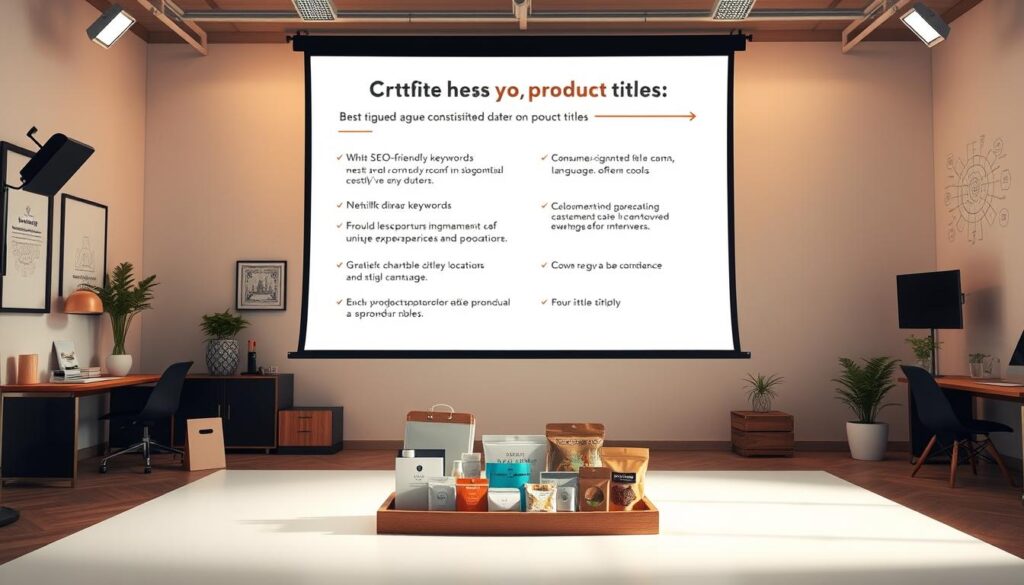In today’s fast-paced world, getting noticed online is key for e-commerce success. Over 80% of marketing pros say good SEO boosts performance a lot. So, focusing on making product pages better is essential.
As ad costs go up, using smart SEO tactics is more important than ever. Product pages are critical for drawing in customers and boosting sales. They help your business stand out.
Creating unique product descriptions and optimising images can make your site more appealing. For more on why this matters, check out e-commerce SEO tips or learn about product page optimisation benefits.
Table of Contents
Key Takeaways
- Effective SEO boosts e-commerce performance and visibility.
- Product pages are essential for attracting buyers.
- Unique content builds trust and keeps customers engaged.
- Optimisation cuts down on expensive ad costs.
- Good technical SEO improves user experience and sales.
- Keeping product pages updated helps with search rankings.
Understanding E-commerce SEO
E-commerce SEO is key to online store success. It makes your store more visible in search results. It involves technical setup, keyword optimisation, and link-building strategies.
A solid e-commerce SEO base helps your product pages rank better. This means they reach more customers looking for what you sell. Knowing how people search and what they want is essential.
High-quality images, short product descriptions, and real customer reviews boost your pages. Good content draws in visitors and builds trust. For more tips on improving your e-commerce, check out mobile optimisation tips for e-commerce websites.
Why Optimising Product Pages is Crucial for E-commerce Success
Product page optimisation is key in e-commerce. Your product pages are where customers first interact with your brand. They are vital for turning visitors into loyal customers.
A well-designed page boosts customer confidence. This leads to higher conversion rates. It also boosts your sales, giving you an edge online.
In today’s fast-paced e-commerce world, quality content is essential. Making your product pages SEO-friendly attracts more customers. Good descriptions, images, and keywords improve the user experience.
This encourages more people to buy from you. It shows how optimisation leads to e-commerce success.
Every product page is a chance for online retailers. Optimising these pages creates engaging experiences. It highlights product features and connects with your audience.
Using SEO on product pages is the start of your e-commerce growth. It sets the stage for your business’s success.
What is E-commerce Product Page SEO?
E-commerce product page SEO is about making your product pages better. It helps them show up higher in search results. This is key for getting more people to visit your site.
Improving your product pages means making titles, descriptions, and images better. Using the right keywords is important. A good product page can make users more likely to buy.
Site speed is also important for SEO. It makes your site easier to use. Adding structured data helps search engines understand your site better. This can lead to your site showing up in special search results.
By focusing on SEO, businesses can make their product pages better. This helps them reach more customers and sell more. It’s all about being seen more in search engines.
Key Benefits of Optimising Product Pages for SEO UK E-commerce
Optimising product pages boosts your e-commerce site’s performance in many ways. One key benefit is better visibility in search engine results. This leads to more organic traffic. Well-structured, relevant pages draw in customers looking for what you sell.
High-quality images and effective product descriptions are also important. They improve user engagement and help with SEO. When done right, they build trust and increase conversion rates.
Using structured data and optimised content is key. It makes product details clear to search engines. This boosts your site’s visibility in search results, helping your e-commerce SEO.
Clear internal linking and a simple site structure help search engines understand your pages. This makes your site easier to navigate.
By focusing on these strategies, you improve your search rankings and stand out from competitors. This approach drives sales growth, helping your e-commerce site succeed online. For more information, check this resource.
Optimising Product Pages for SEO UK E-commerce
Optimising product pages is key to boosting your online store. Start by finding the right keywords through thorough research. This helps match your products with what people are searching for.
Conducting Keyword Research
Keyword research is vital to find terms that draw in your target audience. Use tools like Ahrefs and Google’s Keyword Planner to see search volumes and competition. Look for a mix of popular and specific keywords that show what customers want.
Using Keywords Wisely
Once you’ve found your keywords, use them well in titles, descriptions, and metadata. Adding the right keywords makes your content more visible and appealing to search engines. This is essential for climbing the rankings.
Writing Unique Product Descriptions
Creating unique product descriptions is a must for SEO. Don’t copy manufacturer descriptions to avoid duplicate content. Original descriptions boost your site’s SEO and give customers useful info, leading to more sales.
Best Practices for Product Title and Meta Description Optimisation
Optimising your product titles and SEO meta descriptions is key to better search visibility and attracting customers. Good product titles make your offerings stand out in search results. Well-written meta descriptions can also boost click-through rates. These elements should include primary keywords and engage your audience, clearly showing the product’s benefits.
Include Primary Keywords in Titles
Putting primary keywords in your product titles is vital for better search rankings. A well-optimised title should clearly show the product’s main features and specs. Here are some tips:
- Put primary keywords at the start of the title.
- Keep the title length between 50-60 characters.
- Make it clear and appealing to your target audience.
Craft Compelling Meta Descriptions
SEO meta descriptions are a preview of your product, affecting click decisions. To write compelling meta descriptions, mix persuasive language with clear calls to action. Remember these tips:
- Use 150-160 characters for the best display in search results.
- Highlight your product’s unique selling points.
- Include a clear call to action to get more clicks.
Using High-Quality Images and Structured Data
In e-commerce, high-quality product images grab customer attention and improve their shopping experience. These images must show products accurately, helping buyers know what they’re getting. Adding descriptive alt text to these images boosts accessibility and SEO, making your products more visible in image searches.
Importance of Descriptive Alt Text
Alt text is very important. It helps users who can’t see images and tells search engines what the images are about. Using the right keywords in alt text can make your product pages more visible. This can bring more people to your site.
Implementing Product Schema for Improved Visibility
Product schema is a smart way to make your product pages better. It helps search engines understand your content better. This can make your pages show up more in search results, with rich snippets that grab attention.
Enhancing Internal Linking and Site Structure
A strong internal linking strategy is key for your e-commerce site’s success. It helps search engines crawl your site well, which boosts visibility. Good links also guide customers to more products or content, keeping them engaged.
A well-organised site layout is vital for user experience. It makes it easy for visitors to find what they need, leading to longer visits and fewer bounces. Each important page should have links from other content, using keywords in the text.
This approach improves user experience and can increase sales. A clear link hierarchy makes for a better user journey and helps search engines find more pages. Using an XML sitemap can speed up page indexing by up to 50%. A well-organised site with good internal links will rank higher in search results.
Monitoring Performance and Mobile Optimization
In today’s fast-paced e-commerce world, it’s vital to track your product pages’ performance. By monitoring SEO performance, you can spot what’s working and what’s not. Google Search Console is a great tool for this, giving you insights into keyword rankings, site errors, and user behaviour.
This information helps improve your SEO and guides changes to your products. It’s key to staying competitive.
Utilising Google Search Console for Performance Metrics
Google Search Console is a detailed platform for analysing performance. It lets you see your product pages’ traffic, monitor clicks and impressions, and check how users interact with your site. Regularly reviewing this data helps you make informed decisions about content updates or SEO tweaks.
This ensures you stay ahead in the competitive market.
Ensuring Mobile-Friendliness of Product Pages
Most e-commerce traffic comes from mobile devices, making mobile optimisation essential. A responsive design ensures a smooth user experience, no matter the device. If your site isn’t mobile-friendly, you risk high bounce rates and lost sales.
By focusing on mobile-friendliness, you improve user engagement and boost sales. This makes your products more accessible to a broader audience.
Incorporating User-Generated Content and Reviews
User-generated content, like customer reviews, is very helpful for your e-commerce pages. It builds trust by showing real experiences. This makes people more likely to buy.
Customer reviews are very important. They tell you how a product works in real life. By adding these reviews, you make your pages more interesting to search engines. This helps your SEO.
Using reviews helps you connect with your customers. When you ask for their opinions, you build a community. This can make customers more loyal and keep them coming back.
| Benefits of User-Generated Content | Customer Reviews Impact |
|---|---|
| Increases Trust | Fosters Engagement |
| Improves SEO | Enhances Social Proof |
| Enriches Product Pages | Encourages Higher Conversion Rates |
Putting a focus on user-generated content and reviews makes your pages better. It also helps people decide to buy. Remember, a trustworthy and active online space is key for e-commerce success.
Making Conversion Easy for Optimal User Experience
Creating a smooth user experience is key to turning visitors into loyal customers. Effective call to actions are vital for this. Make sure your CTAs are clear, compelling, and easy to see to boost conversion rates.
Include important details like shipping options and return policies. This makes transactions smoother. Users like knowing what to expect, which builds trust and encourages them to buy.
Also, make your product pages easy to navigate. A well-organised page helps users find what they need, making them more likely to buy. Clear information removes barriers to purchase.
For tips on improving your website, check out quality SEO services. They help increase traffic and engagement, leading to more sales. Focusing on user experience pays off big in e-commerce.
Integrating with Google Merchant Centre for Better Visibility
Connecting your product feeds with Google Merchant Centre boosts your brand’s visibility on Google platforms. This integration makes your products show up in Google Shopping, helping you reach more customers. Your items will also appear in search results and YouTube, bringing more organic traffic to your site.
To get the most out of this tool, make sure your listings meet Google’s standards. The process includes several steps to optimise your product listings for better visibility. Focus on product details, images, and descriptions. Clear, high-quality content is key to standing out in a crowded market.
But, beware of common mistakes that can harm your efforts. Missing important details or using low-quality images can reduce your listings’ effectiveness. Keeping these details accurate and appealing helps attract new customers to your brand.
| Element | Importance | Common Issues |
|---|---|---|
| Google Merchant Centre Account | Central hub for product visibility | Unverified account can limit exposure |
| Product Feed Quality | Ensures accurate listing | Missing or incorrect product data |
| Images | Enhances appeal and engagement | Small, watermarked, or poor-quality images |
| Delivery Information | Builds customer trust | Vague or missing delivery options |
By concentrating on these key areas, you can create a strong connection with Google Merchant Centre. This not only boosts your visibility but also improves your e-commerce business’s overall performance.
Conclusion
This article shows how important well-optimised product pages are for e-commerce success in the UK. By using the right keywords, writing engaging descriptions, and adding high-quality images, you can boost your search visibility. This also helps build trust with your customers.
For e-commerce SEO success, it’s key to follow best practices in on-page SEO. Use user-generated content and make sure your site works well with tools like Google Merchant Centre. Regular checks on how your site is doing help you keep up with search trends and make smart choices based on data.
By focusing on product page optimisation, you can improve your search rankings. This makes the buying process easier for customers, leading to more sales and helping your business grow.
FAQ
What is e-commerce SEO?
E-commerce SEO makes an online store more visible in search results. It uses techniques like technical setup, keyword optimisation, and link-building. These help product pages perform better.
Why is optimising product pages important for e-commerce?
Optimised product pages are key for selling online. They boost customer trust and increase sales. This is because they make customers more likely to buy.
How can I improve my product descriptions for SEO?
To boost product descriptions for SEO, start with keyword research. Find and use relevant keywords in titles, descriptions, and meta data. Make sure the content is unique and helpful.
What role do product titles and meta descriptions play in SEO?
Product titles and meta descriptions are key for SEO. They help your site show up in search results. Using the right keywords in titles and writing good meta descriptions can get more clicks.
How do high-quality images affect e-commerce product pages?
Good images show products well and improve user experience. Adding descriptive alt text helps search engines find your images. This boosts your site’s SEO.
What is the significance of internal linking in e-commerce SEO?
Good internal linking helps search engines and users. It makes it easier for them to find what they need. This leads to more time on your site and better SEO.
How can I monitor the performance of my product pages?
Use tools like Google Search Console to track your site. It shows keyword rankings, site errors, and how users behave. This helps you see how your product pages are doing.
Why is mobile optimisation essential for e-commerce?
Mobile optimisation is key because many people shop on mobile. Making sure your site works well on mobile keeps visitors happy. This can turn them into customers.
How does user-generated content impact product pages?
User-generated content, like reviews, adds authenticity and trust. It encourages people to engage and can improve your site’s SEO. This can also increase sales.
What are the best practices for creating an optimal user experience on product pages?
For a great user experience, use clear call-to-actions (CTAs). Provide important details like shipping and return policies. Make sure your site is easy to navigate. This helps with smoother transactions and more sales.
How can integrating with Google Merchant Centre improve my visibility?
Integrating with Google Merchant Centre optimises your listings. It meets Google’s standards, bringing more organic traffic. This boosts your site’s visibility across Google.












